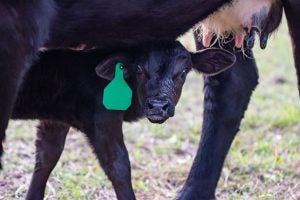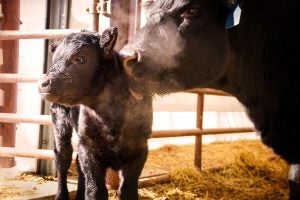Weather is just one factor in having a great calving season. Here in Northeast Kansas we have been dealt some unseasonably warm weather. We have a few days of a cold snap, but then it warms right back up. I’m not complaining. I hate winter. It does make it hard on the animals with the extreme weather swings. We’ve been watching extra close and doctoring as necessary. On our operation, we calve three times per year. But each season looks very different for our calving facilities.
In winter calving, the cows are mature cattle that know how to raise a calf. They are kept close to a barn. Actually we joke about the dairy cows they become. This isn’t their first rodeo at this winter calving thing. Each night, they “go to bed” in the barn. They know when it’s time and they head straight for the barn. Even as the weather warms up and they don’t need to go to the barn, they bring themselves in.
The spring and fall calves come on grass with a pen to haul them to facilities if need be. Each group is different in terms of nutrition and what is required of them. There is emphasis put on keeping the cows in good shape and prepared for whatever season it is.

As we head in to spring calving season, these are a few of the things I’m keeping in mind and thinking through. Each year, cow numbers change and adjustments and pasture rearrangements need to occur.
1. Prior to calving
- Where are you calving?
- Does it have a pen or do you need to set up a temporary one?
- When problems arise, will they stay at the calving location or be hauled to better facilities?
- Are the cows all staying together or are you separating the pairs once calves are born?
- If you’re separating pairs, is the fence tight enough that babies won’t crawl back through it?
- Do you have your equipment ready? Examples: tags, tagger, marker, paperwork to keep track of calves, any shots you give at birth, banding or castrating equipment, pulling necessities (chains, triangle, sleeves, lubrication, vet number), binoculars if you need to watch one calving from afar, four wheeler or UTV or horse ready, baby powder, etc.
2. Calving season
- Is your paperwork staying up to date so you know who has calves and who hasn’t calved?
- If the cows are just headed to grass as they are calving, are they producing too much milk and new babies aren’t getting on quarters?
- Are you exhausted from checking them several times per day?
- If you have one that lost a calf, are you adopting a new one on? If so, we have found a small pen and baby powder is the magic ticket. Sprinkle that stuff liberally on to the calf and the momma’s face and have some patience. We have a 100 percent successful adoption rate using this technique.

3. Post-calving
- Do you have all the medicine you need to work all the babies and mommas after all of them are on the ground?
- Do you need to round up help for working days?
- Will you be transporting them to grass? Is the pickup and trailer ready?
- Store your paperwork in a safe spot so you can see how they grow until weaning and can refer back to it from year to year to see who is a top producing cow and which ones you may need to cull. Maybe even make a copy of the paperwork and put it in a couple safe spots. That way you have a better chance of remembering where that safe spot is!
- Sit back, take your spouse on a date, apologize for the things you’ve said through the season, and have a drink! You got through another calving season! Congratulations.
Calving season is always a favorite season of mine. I love the spring and fall herds the best and love getting to check them twice a day (at least), know all the cows and their personalities, watching the new babies grow and play, and be a part of the process. I wish you the best calving season.
My ag teacher always says, “Maybe next year will be the year I get a 100 percent calf crop.” Know you aren’t the only one who loses calves; things happen no matter how close you watch. Calving season is just that, a season. You’ll get through it and start looking forward to it far before it returns again the next year. Stay safe, be careful around the crazy ones and good luck!
Kelsey Pagel is a Kansas farmer. She grew up on a cow/calf and row crop operation and married into another. Kelsey and her Forever (Matt) farm and ranch with his family where they are living their dream and loving most of the moments.


